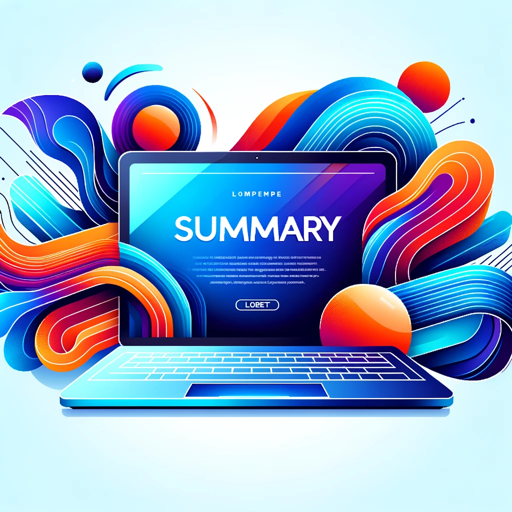Factual Analysis and Critical Text Summary (FACTS)-tool for critical content analysis.
AI-Powered Critical Content Analysis.
What does this agent do? What can it do?
Related Tools
Load More
Study Summary
Summarizes lecture notes into concise, bullet-point summaries for study.

AI Film Critic
Analyzes movies and provides reviews based on cinematic techniques and storytelling.

TLDR Article Summarizer
Summarize articles and web pages: Provides an overview, evaluates pros and cons, poses insightful questions for deeper exploration of the topic, and suggests related articles | #Webpage #Tab #Hoarder #TL;DR #AISalon

Read This Book
Upload your book in pdf or word. Ask any questions you have from the book, or even ask me to quiz you.

Literary Analysis
Engages with interactive elements for deeper text analysis.

IB English Literature - Paper 1 (Textual Analysis)
IB DP English Literature SL -- Analysis Writer (Paper 1)
20.0 / 5 (200 votes)
Introduction to Factual Analysis and Critical Text Summary (FACTS)
Factual Analysis and Critical Text Summary (FACTS) is a structured framework designed to critically analyze news content, ensuring that headlines align with the content, identifying uncertain or manipulative language, and creating fact-based counter-narratives. The primary goal is to provide a comprehensive, objective, and insightful analysis of news articles, helping users to discern the true intent and accuracy of the content they consume. For example, FACTS might be used to analyze a news headline that claims a new policy will 'destroy the economy'. The analysis would involve checking the factual basis of this claim, detecting any speculative or manipulative language, and then crafting an alternative narrative that might highlight potential benefits of the policy, thus providing a more balanced perspective.

Main Functions of Factual Analysis and Critical Text Summary (FACTS)
Headline Analysis
Example
Analyzing a headline that states, 'New Policy Will Lead to Economic Collapse' to determine if it accurately reflects the content of the article.
Scenario
A user uploads an article with a sensational headline. FACTS breaks down the headline to its core claim and compares it with the article’s content to assess accuracy.
Identification of Uncertain Language
Example
Identifying phrases like 'could lead to', 'might result in', or 'experts suggest' within an article about economic forecasts.
Scenario
An article predicts economic downturn, but uses speculative language. FACTS highlights these uncertainties, helping users to gauge the reliability of the predictions.
Manipulative Language Detection
Example
Highlighting emotionally charged words like 'disaster', 'catastrophe', or 'irresponsible' in a piece critiquing a government decision.
Scenario
A user wants to understand potential bias in a politically charged article. FACTS detects manipulative language and explains how it might influence reader perception.
Ideal Users of Factual Analysis and Critical Text Summary (FACTS)
Journalists and Editors
Journalists and editors can use FACTS to ensure their reporting is balanced and factually accurate, avoiding sensationalism and bias. They benefit from tools that help maintain journalistic integrity and build trust with their audience.
Educators and Researchers
Educators and researchers can leverage FACTS to teach critical thinking and media literacy. By using real-world examples of news analysis, they can illustrate how to detect bias, understand uncertainty, and critically evaluate sources.

Steps to Use Factual Analysis and Critical Text Summary (FACTS)
Visit aichatonline.org for a free trial without login, also no need for ChatGPT Plus.
Access the tool through the website without any prerequisites such as signing up or requiring a premium subscription.
Prepare your content.
Ensure that you have the text or news article ready for analysis. You can either upload a document or copy-paste the text into the tool.
Initiate the analysis process.
Once your content is loaded, the tool will begin analyzing various aspects such as headline interpretation, detection of uncertain language, and manipulative phrasing.
Review the output.
The tool will generate a detailed analysis, including a summary of key points, a contrary narrative, and a bias rating.
Utilize the results.
Use the generated analysis for critical evaluation, academic purposes, or to form balanced perspectives on the content.
Try other advanced and practical GPTs
Supplements
AI-Powered Supplement Advisor

Cheemera v1.1
AI-powered logical analysis and inference.

Assistant Idéation
AI-powered LinkedIn post creation tool.

Perfect Image Ver 1.1
AI-powered character illustrations

ThoughtfulTuring
Deep insights powered by thoughtful AI.

Funko Pop Creator
Design Your Own Custom Funko Pop Figures with AI

快適レビュアー
AI-powered writing assistant for reviews

Academic Mentor
AI-powered graduate application assistant

Privacy policy and GDPR Assistant
AI-powered GDPR Compliance Tool

Reverse Engineered
AI-powered reverse engineering made simple.

Hannah Arendt
AI-powered reflective thinking companion.

G-フェルミ先生
AI-powered logical reasoning and estimation

- Critical Thinking
- News Analysis
- Bias Detection
- Content Simplification
- Alternative Narrative
Q&A About Factual Analysis and Critical Text Summary (FACTS)
What is Factual Analysis and Critical Text Summary (FACTS)?
FACTS is a structured framework designed for analyzing news articles. It critically evaluates headlines, identifies manipulative language, and creates fact-based counter-narratives to offer a balanced perspective on the content.
How can FACTS help me analyze news articles?
FACTS assists in critically assessing the alignment between headlines and content, identifying uncertain language, and detecting bias or manipulative language. It simplifies the content and provides an alternative narrative based on facts.
Do I need to be an expert to use FACTS?
No, FACTS is designed to be user-friendly. It guides you through the analysis process, making it accessible even to those without prior experience in critical text analysis.
Can I use FACTS for academic purposes?
Yes, FACTS is well-suited for academic use. It helps in analyzing and critiquing articles, which can be valuable for research, writing assignments, or developing critical thinking skills.
What makes FACTS different from other analysis tools?
FACTS focuses on a comprehensive analysis that includes not just fact-checking but also exploring alternative narratives. It emphasizes the detection of biased or manipulative language and provides a structured approach to ensure a balanced understanding of the content.